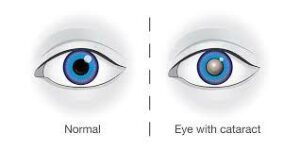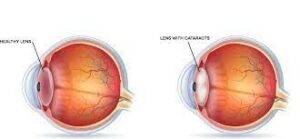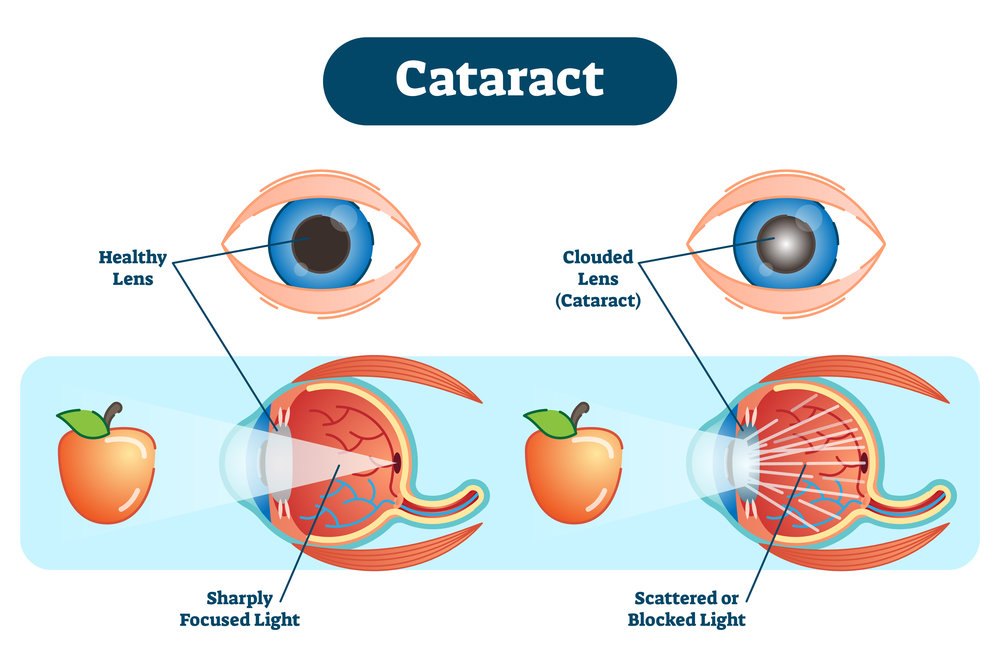Do you know about cataracts? A cataract is an eye disorder that affects the lens of your eye. The lens becomes cloudy, which can lead to vision problems. In this blog post, we will discuss all of the things that you need to know about cataracts. We will cover causes, symptoms, and treatment options. If you are concerned about cataracts or have been recently diagnosed with them, then this blog post is for you!
Contents
What Is Cataract

A cataract is an eye condition in which the lens of the eye becomes cloudy. This can lead to a decrease in vision, often accompanied by glare and halos around lights. Cataracts are most common in people over age 55 but can occur at any age due to inherited genetic disorders or certain diseases such as diabetes. A cataract is one of the leading causes of blindness worldwide.
Can Cataract Be Cured?

Once cataracts form, the only way to get rid of them is through surgery. No existing medication can eliminate existing cataracts, and no eyewear exists that completely counteract their effects. Some ophthalmologists are seeking nonsurgical solutions, but at this time, none have been found.
Is Cataract Surgery Painful?
Although patients are awake during cataract surgery, they usually don’t feel any pain. To help prevent discomfort, doctors may give the patient a mild sedative before the surgery starts. They also use numbing eye drops on the eye being operated on.
Symptoms
There are various symptoms of cataracts:
- Blurry vision, as if you are looking through a foggy or dusty window
- Colors appear faded and less vibrant than before
- Glare from bright lights, such as headlights of oncoming cars at night
- Difficulty reading small print, even when wearing glasses
- Double vision in one eye
- Frequently changing prescriptions in eyeglasses
- Poor night vision
- Halos around lights, or a “halo effect”
If you experience any of these symptoms, it is important to visit an ophthalmologist for a professional diagnosis. Early detection and treatment can help prevent the progression of cataracts and preserve your sight.
Causes
There are various causes of cataracts:
This is the most common type of cataract, which develops gradually over time as part of the aging process.
Traumatic cataract
Caused when an injury or trauma to the eye causes the lens to become cloudy.
Congenital cataract
Present at birth and may be caused by a genetic mutation or a mother’s exposure to infections during pregnancy.
Secondary cataract
They are caused by the long-term use of certain medications, such as steroids, or medical conditions like diabetes.
Radiation cataract
They are developed after exposure to high doses of radiation.
Drug-induced cataract
Caused by medications or substances, such as alcohol and tobacco, that can damage the lens of the eye.
Cortical Cataract
This type of cataract begins in the outer edges of the lens and gradually spreads inward over time.
Treatment
There are various treatment options for cataracts:
Surgery
This is the most common and effective way of treating cataracts and involves removing the cloudy lens and replacing it with an artificial intraocular lens (IOL). Cataract surgery is a safe and relatively painless procedure. The success rate for cataract surgeries is very high and complications are rare.
Medicines
Some medications such as eye drops may be used to slow the progression of cataracts, ease symptoms and improve vision. However, these medicines are not a cure for cataracts.
Laser Therapy
This is a newer treatment option and involves using the laser to remove the cloudy lens without requiring surgery. It is less invasive than traditional cataract surgery but it may not be suitable for everyone.
It’s important to consult with your doctor before deciding on the best course of action to treat cataracts. Your doctor will be able to recommend the best treatment option for your particular case based on your medical history and other factors. Depending on the type, location and severity of cataracts, one or more treatments may be recommended. Ultimately, the goal is to improve vision and prevent further damage to the eye.
How Long Does Cataract Surgery Take?
Cataract surgery is a quick and easy procedure that only takes around 30-45 minutes. You will be given local anesthesia so you won’t feel any pain, and it’s often done as day surgery so you can go home the same day. The surgeon will make a tiny incision in the eye and then use ultrasonic waves to break up the cataract lens. The broken-up pieces of the cataract are then removed and replaced with an artificial one. Your vision should start to improve almost immediately, although it may take several weeks for your vision to stabilize fully. After surgery, you may need to wear special protective sunglasses and use eye drops for a few weeks, but most people make a full recovery in just a few days.
Prevention Tips About Cataracts
There are various tips about cataracts:
Wear Sunglasses
Wearing 100% UV-protected sunglasses outside can help prevent cataracts from forming in the future, as well as protect your eyesight and reduce discomfort.Eat Healthy Foods
Eating a balanced diet rich in fruits and vegetables is important to maintain healthy vision, as they are full of antioxidants and vitamins like Vitamin A, C and E which help protect the eyes from damage.Taking certain dietary supplements such as omega-3 fatty acids, vitamin E, lutein and zeaxanthin may help slow the progression of cataracts.
Quit Smoking
Smokers are more likely to develop cataracts than non-smokers due to the toxins that can accumulate in the eye over time. So it is important to quit smoking as soon as possible.
Get Regular Eye Exams
Early detection and treatment of cataracts are important, so it is recommended to get an eye exam at least every two years. This will help ensure that cataracts are detected and treated in a timely manner.
Wear Protective Eyewear
Wearing protective eyewear while participating in sports or other activities can help protect your eyes from injury, which is one of the main causes of cataract formation. Use Quality Eye Drops
Using quality eye drops
can help to keep your eyes hydrated and reduce the risk of cataract formation. They can also help to reduce the symptoms of redness, dryness, and itching that are associated with cataracts.
Following these tips can help to protect your eyes and prevent cataracts from forming. It is important to seek medical attention if any unusual changes in sight occur. Cataracts can be difficult to treat, so it is best to take preventive measures early on.
Conclusion
A cataract is about more than just vision loss. It can take a toll on the quality of life, affecting everyday activities and potentially leading to depression. Fortunately, advances in medical technology have made cataract surgery much safer and more effective than it was even just a few years ago. With modern treatments, most people with cataracts are able to regain clear vision without any major complications. Talk to your doctor if you suspect you may have a cataract so that you can explore the options available to help restore your vision and improve your quality of life.
Cataract surgery is a safe and painless procedure. At MantraCare we have a team of experienced eye surgeons, who will be happy to answer your any questions on cataract surgery. Call us at +91-9711116605 for any inquiries.
